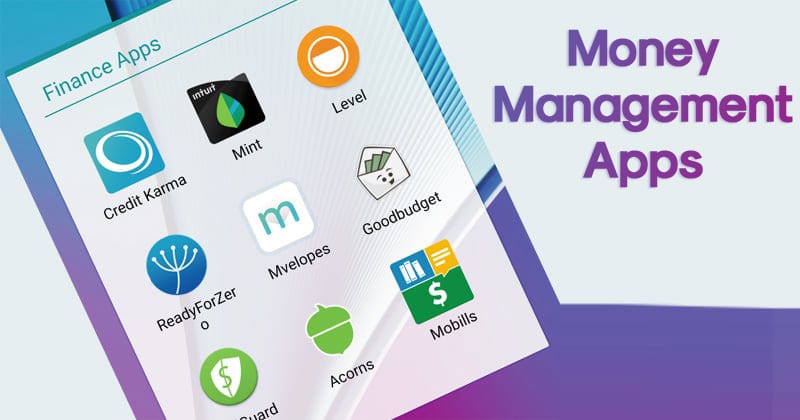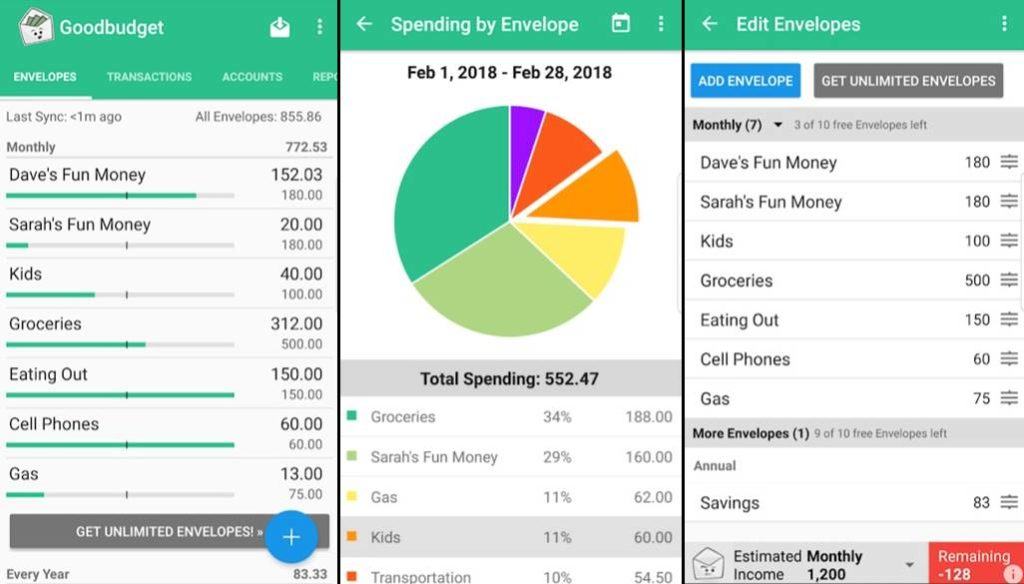Money management apps have revolutionized personal finance, empowering users to take control of their financial well-being. With a myriad of features and integrations, these apps offer a comprehensive solution for budgeting, expense tracking, and financial planning.
From budgeting tools to investment tracking, money management apps cater to a wide range of financial needs. They simplify complex financial concepts, making it easier for individuals to manage their money effectively and achieve their financial goals.
Overview of Money Management Apps

Money management apps are digital tools designed to help individuals track their financial transactions, manage their budgets, and achieve their financial goals. They offer a range of features that automate tasks, provide insights, and simplify the process of managing personal finances.
Using money management apps can provide several benefits, including:
- Improved financial visibility: Apps track income, expenses, and account balances in one place, giving users a clear picture of their financial situation.
- Budgeting assistance: Apps help users create and track budgets, ensuring they stay within their financial limits and reach their savings goals.
- Automated transactions: Some apps offer features like automatic bill pay and recurring transfers, saving users time and reducing the risk of missed payments.
- Personalized insights: Many apps provide personalized insights into spending habits, identifying areas where users can save money or improve their financial health.
Popular Money Management Apps
Numerous money management apps are available, each with its unique features and target audience. Some popular options include:
- Mint: A comprehensive app that offers budgeting, expense tracking, and investment tracking.
- YNAB (You Need a Budget): An app designed specifically for budgeting, with a focus on the “envelope” method.
- PocketGuard: An app that provides real-time expense tracking, budgeting, and personalized financial recommendations.
- Clarity Money: An app that focuses on financial planning and debt reduction, with features like automated debt repayment.
- Goodbudget: An app based on the “envelope” budgeting system, designed to help users stay within their budget and reach their financial goals.
Features of Money Management Apps
Money management apps offer a range of features designed to help users manage their finances effectively. These features can be broadly categorized into three types: budgeting, tracking expenses, and financial planning.
Budgeting
- Create and manage budgets for different categories, such as food, entertainment, and transportation.
- Set financial goals and track progress towards them.
- Receive alerts when spending exceeds budgeted amounts.
Tracking Expenses
- Automatically categorize transactions and track expenses in real-time.
- Generate reports and insights to identify spending patterns and areas for improvement.
- Link to bank accounts and credit cards for seamless data import.
Financial Planning
- Set financial goals, such as saving for a down payment or retirement.
- Create investment portfolios and track performance.
- Receive personalized recommendations and advice based on financial situation.
Advanced features available in some money management apps include:
Investment Tracking
- Monitor stock, bond, and mutual fund investments.
- Receive real-time updates on market performance.
- Analyze investment portfolios and make informed decisions.
Debt Management
- Track outstanding debts and create repayment plans.
- Receive alerts when payments are due.
- Explore debt consolidation options.
Personalized Recommendations, Money management apps
- Receive tailored financial advice based on individual spending habits and goals.
- Get personalized recommendations for budgeting, saving, and investing.
- Access educational resources and support from financial experts.
When choosing a money management app, it is important to consider the features that align with individual financial needs. Apps with a wide range of features can provide comprehensive financial management, while those with a more focused set of features may be suitable for specific tasks, such as budgeting or debt management.
Budgeting with Money Management Apps

Money management apps offer robust budgeting features to help users create and manage their financial plans effectively. These apps provide a user-friendly interface that simplifies the budgeting process, enabling users to track their income, expenses, and savings goals with ease.
Setting Up a Budget
To set up a budget within a money management app, users typically start by inputting their income sources, including salaries, wages, and any other regular inflows. Next, they categorize their expenses into fixed costs (e.g., rent, mortgage, insurance) and variable costs (e.g., groceries, entertainment, dining out).
Users can also set savings goals, such as an emergency fund or a down payment on a house.
Tracking Expenses
Money management apps provide real-time expense tracking capabilities. Users can manually enter their transactions or connect their bank accounts to automatically import expenses. The app categorizes expenses, allowing users to easily identify areas where they may be overspending. This granular level of tracking helps users make informed decisions about their spending habits and adjust their budget accordingly.
Identifying Savings Opportunities
By analyzing expense patterns, money management apps can identify potential savings opportunities. They provide insights into areas where users may be able to reduce unnecessary expenses, such as subscriptions or impulse purchases. The app can also suggest alternative options for essential expenses, such as finding cheaper insurance or negotiating lower bills.
Security and Privacy Considerations: Money Management Apps
Money management apps implement various security measures to protect user data, ensuring the confidentiality and integrity of sensitive financial information. These measures include:
Data Encryption
Data encryption involves converting sensitive information into an unreadable format, making it inaccessible to unauthorized individuals. Money management apps employ robust encryption algorithms to safeguard user data, both during transmission and storage. This encryption ensures that even if data is intercepted, it remains protected.
Two-Factor Authentication
Two-factor authentication (2FA) adds an extra layer of security by requiring users to provide two different forms of identification when logging into their accounts. This typically involves entering a password and a one-time code sent via text message or email.
2FA helps prevent unauthorized access, even if a user’s password is compromised.
Other Security Features
Additional security features employed by money management apps include:
- Biometric Authentication:Using fingerprint or facial recognition for secure login.
- Regular Security Audits:Conducting regular security audits to identify and address potential vulnerabilities.
- Compliance with Industry Standards:Adhering to industry-recognized security standards, such as the Payment Card Industry Data Security Standard (PCI DSS).
Choosing a Secure App
When selecting a money management app, it is crucial to prioritize security. Look for apps that:
- Implement robust encryption protocols.
- Offer two-factor authentication.
- Have a proven track record of security and privacy protection.
- Are transparent about their security measures and data handling practices.
By choosing an app with strong security protocols and a commitment to user privacy, you can ensure the safety of your financial data and minimize the risk of unauthorized access or data breaches.
Integration with Other Financial Tools

Money management apps seamlessly integrate with a wide range of financial tools, enabling users to consolidate their financial data and streamline their financial management.
By connecting to bank accounts, credit cards, and investment platforms, money management apps automatically import transactions, categorize expenses, and track balances. This eliminates the need for manual data entry, reducing errors and saving time.
Automated Transactions
Integration with financial tools also allows for automated transactions, such as:
- Scheduled bill payments
- Automatic transfers between accounts
- Investment contributions
These automated transactions reduce the risk of missed payments, improve cash flow management, and help users stay on track with their financial goals.
Examples of Successful Integrations
Examples of successful integrations include:
- Mintintegrates with over 20,000 financial institutions, providing a comprehensive view of a user’s financial health.
- Personal Capitalconnects to investment accounts, offering users a holistic view of their portfolio and retirement planning.
- Quickenallows users to manage their budget, track investments, and connect to over 14,000 banks and credit unions.
These integrations enhance the overall financial management experience by providing users with a centralized platform to manage all their financial accounts, automate transactions, and make informed financial decisions.
User Experience and Interface

The user experience and interface of money management apps play a crucial role in determining their usability and effectiveness. Intuitive navigation, clear data visualization, and customizable dashboards are essential for users to manage their finances effortlessly.
Intuitive Navigation
Seamless navigation allows users to quickly access the features they need without getting lost or confused. Apps should have a logical structure, clear menus, and easy-to-follow instructions.
Clear Data Visualization
Data visualization is key to understanding financial information. Money management apps should present data in a visually appealing and easy-to-understand manner. Charts, graphs, and tables can help users visualize their spending patterns, income sources, and overall financial health.
Customizable Dashboards
Personalized dashboards allow users to tailor the app to their specific needs. They can customize widgets, rearrange sections, and create shortcuts to frequently used features. This level of customization enhances the user experience and makes the app more efficient.
Recommendations for User-Friendly Apps
Several money management apps offer excellent user experience and interface. Here are a few examples:
- Mint:Intuitive navigation, comprehensive data visualization, and customizable dashboards.
- YNAB (You Need a Budget):Envelope-based budgeting system, clear progress tracking, and visually appealing charts.
- Goodbudget:Collaborative budgeting, customizable categories, and visually appealing reports.
Pricing and Value
Money management apps offer a range of pricing models to cater to different user needs and budgets. These models typically fall into three categories: free, subscription-based, and premium.
Free apps provide basic features such as budgeting, expense tracking, and account aggregation. Subscription-based apps offer more advanced features such as customized budgeting tools, investment tracking, and financial planning. Premium apps provide the most comprehensive set of features, including personalized financial advice, tax optimization, and portfolio management.
Free Apps
- Typically offer basic budgeting and expense tracking features.
- May include limited account aggregation and reporting capabilities.
- Supported by advertising or in-app purchases for additional features.
Subscription-Based Apps
- Offer more advanced features than free apps, such as customized budgeting tools and investment tracking.
- Typically charge a monthly or annual subscription fee.
- May include premium features such as financial planning and personalized advice at higher subscription tiers.
Premium Apps
- Provide the most comprehensive set of features, including personalized financial advice, tax optimization, and portfolio management.
- Typically charge a higher subscription fee than subscription-based apps.
- May offer additional services such as financial coaching or access to financial experts.
The best pricing tier for an individual depends on their budget and financial needs. Those who need basic budgeting and expense tracking features may find a free app sufficient. Those who want more advanced features and personalized advice may benefit from a subscription-based or premium app.
Ending Remarks
Whether you’re looking to create a budget, track expenses, or plan for the future, money management apps provide an invaluable toolset. By leveraging technology and automation, these apps empower users to make informed financial decisions and build a strong financial foundation.
FAQ
What are the key features of money management apps?
Money management apps typically offer features such as budgeting, expense tracking, financial planning, investment tracking, and debt management.
How do money management apps help with budgeting?
Money management apps assist with budgeting by providing tools to create and manage budgets, track expenses, and identify areas for potential savings.
Are money management apps secure?
Reputable money management apps implement robust security measures such as data encryption, two-factor authentication, and strong privacy protocols to protect user data.
How do money management apps integrate with other financial tools?
Money management apps often integrate with bank accounts, credit cards, and investment platforms, enabling seamless data synchronization and automated transactions.
